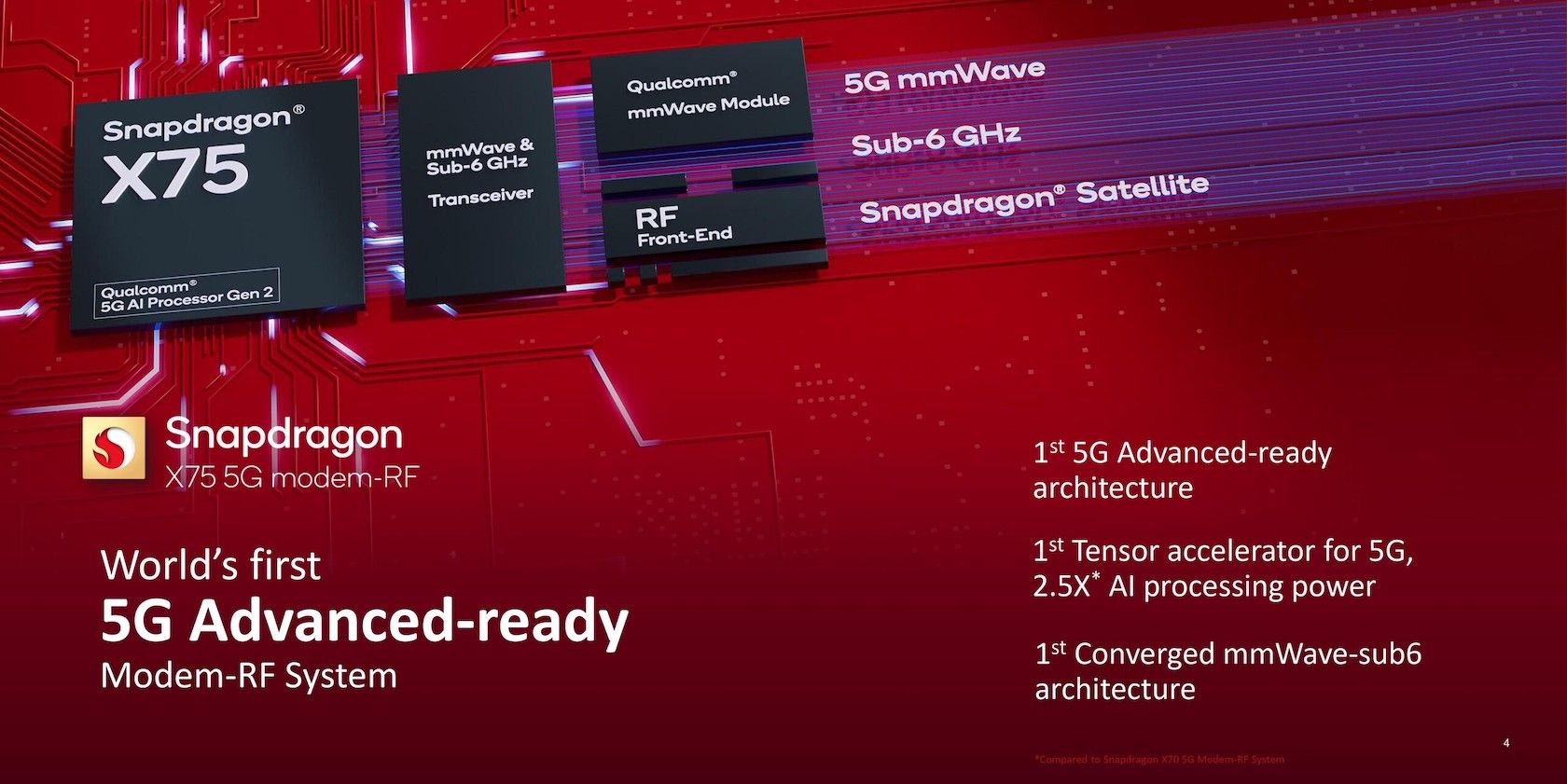There are so many ways AI is already incorporated into smartphones, working behind the scenes to enhance day-to-day life. From voice assistants to photo quality to facial recognition, your phone is programmed to optimize performance through data analysis. But the next generation of smartphones is about to get even smarter, thanks to the new Snapdragon® X75 5G Modem-RF System from Qualcomm Technologies, Inc., which uses AI-based beam management to improve the signal.
The Snapdragon X75 is the smartphone communication engine that moves the needle on device connectivity. This is Qualcomm’s 6th generation modem-to-antenna 5G solution and the first Modem-RF System with a dedicated AI tensor accelerator—the Qualcomm 5G AI Processor Gen 2—which allows for enhanced 5G connectivity.
Snapdragon X75 offers 2.5 times better AI performance than the groundbreaking Snapdragon X70, so our connected devices can make the best sense of an increasingly complicated wireless world. AI enhancements also allow for better speeds, coverage, mobility, link robustness, and location accuracy. For example, AI-enhanced GNSS Location Gen 2 allows for up to 50% improved location tracking accuracy¹.
This modem-to-antenna solution features new modem-RF architecture and software. Architecture refers to the way the different components work together. Thanks to the Snapdragon X75’s new converged mmWave-sub6 architecture and new mmWave antenna module Qualcomm® QTM565, hardware footprint, cost, design complexity and power consumption are reduced.
While the new Qualcomm® Advanced Modem-RF Software Suite—software being the bundle of programs telling the device what to do—improves sustained performance in locations like subways, elevators, airports, parking garages, and more, so your calls almost never drop no matter where you are.
The upgradable architecture is also built for scalability as new 5G features are introduced. Beyond smartphones, this 5G Advanced-ready solution is set to power the next stage of 5G evolution across segments—think smartphones, mobile broadband, automotive, compute, industrial IoT, fixed wireless access and 5G private networks.
Makeuseof editor James Bruce sat down with Sunil Patil, VP of product management, Qualcomm Technologies Inc., to learn more about what the X75 means for all smartphone users of the near future. Here’s a bit about what Bruce learned.
X75 Will Bring Mobile Gaming More in Line With PC Gaming
Patil explained that the X75 platform introduces several new features, such as higher carrier aggregation, which results in higher data rates in downlink and higher data speeds in uplink. Multiple input, multiple output (MIMO) in uplink will result in smoother experiences for mobile gaming users. Additionally, improved coverage will mean continuous access to mobile gaming in more locations.
Enhancements for Users Who Don’t Have Access to 5G in Their Area
These coverage-related enhancements won’t just benefit gamers. AI-based beam management specifically targets expanding millimeter wave coverage at the cell edge (the edge of a cellular network's coverage area.) This will improve coverage even in areas where it currently might not be feasible. Additionally, uplink MIMO can help extend the coverage for users away from the cell edge.
What Smartphone Users Can Expect to Change With X75
According to Patil, the Snapdragon X75 will help provide users with a higher data rate, meaning more data can be transferred over a network or communication channel in a given amount of time. This results in faster download and upload speeds, smoother video streaming, quicker web page loading times, and a generally better user experience with various data-transferring applications on devices.
Additionally, with Snapdragon’s new modem-RF architecture, the chip will be more power efficient, so users can operate their smartphones longer.
Tangible Daily Uses for AI-Based Location Accuracy
Traditional location tracking methods have relied on location data from multiple sources, such as GPS, Wi-Fi, and network cellular signals, which can all be negatively impacted by something as simple as weather or a building.
AI-based location techniques will analyze other factors, like movement patterns and historical data, to improve location accuracy. So Patil is confident that locating family members or friends at a music festival, for example, will become faster and more accurate.
How X75 Can Be Used in Other Technology in the Future
Patil explains that this modem platform is completely scalable, and the goal is that this will enable different use cases. All the capabilities that have been mentioned can be utilized by automotive and other industries; it's just a matter of time.
As you can see, there is no limit to the number of ways in which AI can enhance day-to-day life. Thanks to Snapdragon X75, smartphones of the future will be optimized for enhanced communications. Not just for techies and gamers, these technological advancements are something that everyone should be excited about.
If you’ve ever lost your friends at a music festival, been stranded on a stopped subway car with low service, or suffered a tarmac delay out of range of the airport Wi-Fi, you’ll understand how life-changing this will be.
Watch the full interview with Qualcomm Technologies below.
¹ Compared to non-AI-based location tracking; Under a typical GNSS-challenged dense urban canyon environment
This is a sponsored post. The product choices and opinions expressed in this article are from the sponsor and do not reflect the editorial direction of MakeUseOf or its staff.

